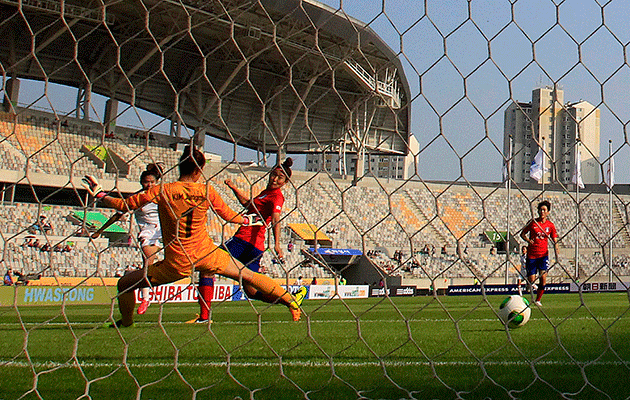On September third, the Republic of Korea played Laos as part of their qualification campaign for the 2018 World Cup. But instead of playing in the Seoul World Cup stadium, or any other World Cup stadium for that matter, they played in the Hwaseong Stadium, built four years ago, in the middle of nowhere, and without a professional tenant club.
Playing international friendlies in different stadia around the country does have some benefits. When Wembley was being reconstructed, fans in the north of England were given the opportunity to watch their national side play without having to make the long trip down to London. However, Hwaseong is not only relatively close to Seoul, but the stadium itself is in the middle of nowhere, attached to the village of Hyangnam-Eup, which has a population of around 50,000 people.
Like many villages in the area, Hyangnam-Eup could be described as ‘skyscrapers in rice paddies’, the village consists of two blocks worth of apartment buildings, each about twelve stories high, and not a lot else. The walk from the village to the out-of-place metal and concrete behemoth takes fans past allotments growing red peppers, along cracked pavements, and across an overgrown brook.
Most of the residents of the village commute to Seoul or the nearby city of Suwon for work, so could clearly commute to those cities to watch an international match if they so wished. The village is tough to reach by public transport with the last bus to Seoul departing the village at 9.40pm. There are plans to connect the village to Seoul’s subway network, but it will be the final stop on the line when the subway is finally extended here at some point in the 2020’s.
Hwaseong stadium, with its smooth silvery exterior resembling some kind of space-ship dropped in the Korean countryside, has no other purpose for its existence. The local football team, Hwaseong FC, use the complex’s training pitch as their home ground, and have perhaps two hundred fans. With one small stand, the training pitch is well suited to their current level. The complex also contains a gymnasium which is home to the IBK Altos, a female volleyball team.
Fans at September’s world cup qualifier had to peer across a running track to be able to see the action on the pitch, including new Tottenham signing Son Heung-Min bagging a hat-trick and hot-prospect Kwon Chang-Hoon scoring his first two goals for the national team. As well as the poor view, fans have to contend with the lack of facilities inside the stadium. Korea’s usually lax regulations regarding bringing food and drink into the stadium get replaced by FIFA’s more stringent rules whenever an international match occurs. This rule often catches Koreans unawares and leads to hour-long queues at the one or two kiosks that are actually inside the venue.
Despite the running track, the primary purpose of the stadium is allegedly football, but without a well-supported team to play there, it is reliant on handouts in the form of occasional international friendlies in order to ever get used. With the exception of the inhabitants of Hyangnam-Eup and other nearby villages, a trip to watch a match here is a huge and unnecessary inconvenience.
When the country co-hosted the World Cup in 2002, it built stadiums that were far larger than would have actually been required to meet the local demand for football. Only three K-League clubs get regular crowds of over ten-thousand, so matches in the 50,000 plus seat stadia, complete with athletics tracks, leads to an atmosphere that is thinner than the moon’s.
After the World Cup, the country at least tried to prevent these stadia from becoming white elephants, parachuting new clubs into these new venues. The way in which that was done was certainly controversial though, with Anyang LG Cheetahs being forced to relocate fifteen miles up the road to the Seoul World Cup stadium, with the club being renamed FC Seoul. Such a move sparked anger with the Anyang supporters, so much so that their owners, LG, were not allowed to name the new team after themselves.
However, at least it was still possible for the fans of Anyang to visit the new team if they so wished. Fans of Bucheon SK, a team based in one of Seoul’s sprawling satellite cities, were not so lucky.
Jeju Island, a large volcanic island off Korea’s south coast, played host to the World Cup by constructing a new stadium, supposedly designed to look like a volcano itself. Rather than being built in the relatively large Jeju City, the new stadium was placed in Seogwipo, a small town on the southern side of the island.
After hosting three World Cup matches, the stadium had no use, so Bucheon SK were relocated 481 kilometres south to the vacant ground. Fans of Bucheon and Anyang had to campaign for years before the introduction of the K-League’s second tier allowed professional football to return to those cities.
At least South Korea can be credited for trying its best to find a use for the World Cup stadiums post-2002. Many of the venues built for the South Africa and Brazil World Cups have been severely under-used since their construction, with Arena Amazonas in Manaus just one example of a stadium built for the World Cup without a realistic plan for its use after the event, the 2022 World Cup in Qatar is also likely to leave behind a legacy of un-needed stadiums gathering sand. Despite the Korean governments best efforts, most of the stadiums built for 2002 still fail to make a profit, with operating expenses higher than match day revenue.
The World Cup stadiums aren’t the only oversized stadiums in the country, in fact the stadium that Bucheon SK were evicted from, with a capacity of thirty-five thousand, is of a similar size to the Jeju World Cup stadium that the team were moved to.
Given that the current tenants, the reformed Bucheon FC 1995, only have an average attendance of just over a thousand supporters, there are a lot of seats left to collect dust. The rest of Korea’s second tier paints a similar picture.
Last season, the average stadium capacity was just over thirty-four thousand but the league’s average attendance was just over one thousand people per match. It is hard to imagine a league with a higher proportion of empty seats than Korea’s second tier. Teams currently do a lot to try and attract supporters.
Temporary stands have been built over running tracks in order to provide a better view for supporters, half time entertainment including singers from flavour-of-the-month pop acts are put on to try and attract families, and games are advertised on banners throughout cities in Korea.
But despite all of these efforts, stadiums even in places where there is a substantial population remain almost empty. Top flight club Busan IPark for instance, despite being based in the second biggest city in Korea, have averaged less than four thousand supporters per game, with baseball rather than football being the live sport of choice for the port city’s residents.
The only mitigating factor is that with most of these stadiums being in relatively large cities, if the quality and popularity of domestic football in Korea were to improve significantly, then these stadia would at least have a chance of being filled. However, even when dropping below the second tier, large stadiums still exist, some of which don’t even have tenant clubs in the Korean fourth tier. The city of Jinju for instance, not content with one empty 20,000 seat stadium, built a brand-new second stadium in 2010 for a national sports festival.
Despite the top tier of Korean football getting attendances similar to League One, and the second tier getting Conference level attendances, there are almost as many 30,000 seat football stadiums in Korea as there are in England, such is the stadium building epidemic. The less said about the attendances in the third and fourth tier of Korean football the better.
It could be argued that the old civic stadiums, being primarily a concrete bowl with changing facilities, were relatively cheap to construct. But such an argument doesn’t apply to Hwaseong stadium, which cost over $175 million to build. For such an outlay, the stadium has hosted a few international matches that could have been played elsewhere, one round of the East Asian Cup where Korea played out a bore draw with China, and several matches in the 2014 Asian games, which could have been played in nearby Bucheon, Seoul, or Anyang instead.
For fans, reaching the stadium isn’t easy, even from other parts of Hwaseong. The village itself has very limited facilities and so the local economy hardly benefits at all from matches being played there, except for a few more customers at the dozen or so restaurants in the village.
Whether it was hubris, corruption, or an attempt to make Hwaseong famous for something other than the serial murders that occurred there in the 1980s, the reason behind the stadium’s construction wasn’t a sporting one. With most of Hwaseong’s population living closer to the Suwon World Cup stadium, it is unlikely that they would choose to travel further to support a fourth tier team over Suwon’s far more successful top-flight club. With no real chance for any domestic games to be hosted there except for a few youth internationals, Hwaseong will have to wait until next time Laos roll into town before the shiny 35,000 capacity spaceship sees any more decent crowds.
By Steve Price







